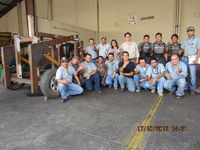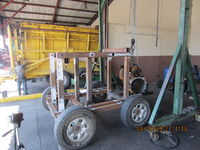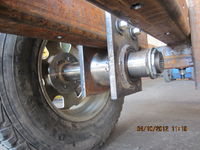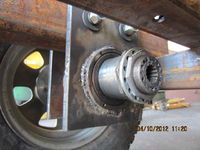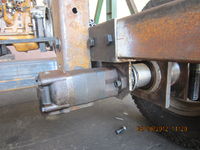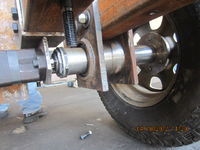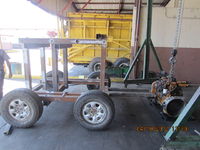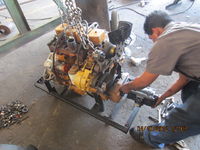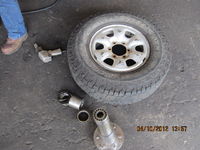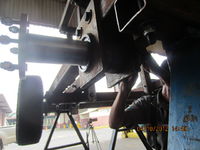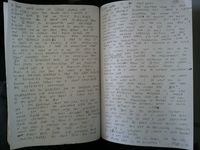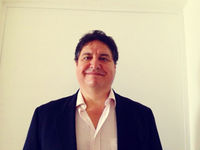Guatemala Log
Project Plan
OSE - Guatemala - Ingenio Santa Ana Proposal.pdf
This is the development plan written in Q3 2012 for the rest of the year and the first half of 2013. As developments progress, it will be updated.
Logic Model
Media
Photographs
Photograph Links
- Manuel's Land - Guatemalan Village Site - Flickr
- November 3rd Update - Flickr
- October 17th Update - Flickr
- September 27th Update - Flickr
Videos
LifeTrac Replication 01
- https://www.youtube.com/watch?v=MtFs8KzNN44&feature=g-upl - PowerCube remount (@32x)
- https://www.youtube.com/watch?v=ul2M6y5MfjE&feature=g-upl - PowerCube unmount (@16x)
- https://www.youtube.com/watch?v=qI2lptqgV5Q&feature=g-upl - First drive (@32x)
- https://www.youtube.com/watch?v=eGJIiHs9UMM&feature=g-upl - Loader arm in operation (@16x)
- https://www.youtube.com/watch?v=nDznPgXqxCI&feature=g-upl - 1hr of work on Loader Arm (@62x)
- https://www.youtube.com/watch?v=_af2IAESwhU&feature=g-upl - Brief recap of the PowerCube
- http://youtu.be/7Qk94hWtIlk
- http://youtu.be/A_oDBwbwDIs
- http://youtu.be/WffdwyJ1Sqo
- http://youtu.be/IO7-_I040gc
- http://youtu.be/OGB4M_sGWQc
CAD
LifeTrac Replication 01
- Ingenio Santa Ana - Wheel CAD
- Detalle de Bufa 01
- Detalle de Bufa 02
- Detalle de Eje
- Detalle de Power Cube
- Detalle de Soporte de Motor Hidraulico
- Detalle de Soporte Power Cube
- Detalles de Engranaje, Bushing, Esparrago, Cuna
Log
March 3, 2013
Manuel
Hi Aaron,
Just checking in about a couple of things. We got contacted by someone from a Korean channel about coming down and doing a segment on our replication efforts. They did it kind of last minute, so it's not a guarantee that the guys at the mill will be able to squeeze in some time, we're still checking. I did talk with Andres though, expressed continued interest in that and checking to see if it will be possible to have them when the Koreans want to come. The zafra ends in May, so any of your own plans for filming are probably best worked around that time.
The Koreans also told me Factor eFarm closed? What's the status over with you guys?
Be well, Manuel
November 5, 2012
Awesome. A few briefs,
1. Logic Model: I never actually did comment in detail, but how you mapped it looks great. It all looks perfect, but for a couple of minor comments.
a) the Technology-Transfer Institute (with the gov. and the gov. of Taiwan) is on hold on their part until further notice (it was a separate, independent group). I was going to be a designer/advisor to that project and execution is not really in my hands, and as often happens when several large slow institutions try to do something together. It could start in 6m, 1yr, or never - so I would just scratch it from the Model for now, I need to learn to not prematurely disseminate information that could not materialize beyond my control.
b) Santa Ana will also be involved in some initial training, which will then realistically spread robustly to the villages (which ties in nicely to the OSE Campuses, more below)
2. TEDxMadrid video: @Aaron, you did a great job! It's nice that the 10min allowed you to go into a bit more detail and also do a substantial update since Marcin's talk. Thanks for the nice blurb about our efforts at the end.
3. OSE Strategic Plan: I made a few comments in the doc, but I wanted to tell you guys that I think it's great stuff! I think the OSE Incubators and OSE Campuses are a fantastic idea and it's wise on your part to understand that this is the first step, building and educating a core of people, that can then use and spark others in using the great free digital libraries of tools you're creating. I also think it is a fantastic idea that the OSE Distributive Enterprise Fellows will earn Capital during their 2-yr program, which will then serve as seed money for their own incubator in their own country.
In general, I think having a well-thoughout strategy such as you have laid out is important, as well as knowing that plans have to be flexible to a degree, especially since this is such a people-centered ecosytem-based vision, in such a distributed and open-source way: people will make it their own. While this is generally true, what made me think of it is your plan to focus on OSE Incubators first and then once 144 is reached in ostensibly 2022 - you will switch to training OSE Fellows? The way I understood it, for the first 10 years, you will only train people in fabrication and in training others - then after 2020, OSE Campuses and OSE Fellows would then start doing community development work?? If I did understand correctly - I can see where you are coming from - but I would still see it differently. Once OSE-trained Fellow (the first 12) return to their countries with $100k and 2yrs of training - I'm sure most will be eager to keep putting their skills to valuable practical use (in addition to training others). I know I would. I know you could always make anything "mandatory" or "contractual, but a more realistic approach is to examine people's motivations and expectations first.
Coincidentally $100k is the amount of money I budgeted for my village (the balance will come from different sources), and that money got me 32 acres (here is the site, check out the pictures, http://www.flickr.com/photos/60350032@N03/sets/72157631886102452/) and will build my house (a 1300 sq ft Superadobe Palace) + 2/3 other houses for families + first 1yr worth of seeds and agriculture stuff for myself and 5 families.
As an entrepreneur in the developing world with this Open-Source, Freedom, Justice, EarthHugging itch - I fancy myself quite familiar with the mindset of likely candidates for OSE Fellows. I would definitely be ready to hit the ground running after a 2 yr immersion program and start building machings and doing community development AND train others. Sure, the training of the 2nd generation is of paramount importance - but I think it need to come at the expense of potentially losing interest of the 1st generation. 2 years is a big time commitment (it's a degree) - perhaps for you guys it doesn't sound as much in a 15-yr plan - but to the people to whom you will be pitching, it is. As such, I think the reward of production and community engagement could happen first. Regardless what you decide, I think it will be difficult to stop otherwise, so might as well regulate it.
Anyway, just food for thought, there is plenty of time. Much later on, if I can help in any way with Ideas or anything for the OSE Fellows program, I'd love to help out. It will be essentially integrated into our efforts here in Guatemala of course, and we look forward to continued development. Talk soon
- Manuel
November 4, 2012
Josh et al., read my response in attached file. This is regarding motion forward on power cubes and wheel drive - critical modules in development. Antonio is our Guatemala TED Fellow connection who has made I great strides forward with.initial test drive of their Lifetrac IV replication. I see us all contributing fundamentally to the next generation of this planet's modular vehicle design. Open source, of course.
- Marcin
A 150Hp Powercube sounds great! We did a 90hp version of the P.C. for our Lifetrac replication because that is the engine we had on hand - but I'd be very interested in the added power and versatility of a robust 150hp version. Here is a brief video of our recently completed Powercube, it's simple, just built to work for now (https://www.youtube.com/watch?v=_af2IAESwhU&feature=g-upl)
I also LOVE the idea of a hybrid hydraulic/direct drive system - I will bring it up with the team to see if we can start thinking about it for our 2nd replication.
Peace!
- Manuel
PS: We are considering using a much larger hydraulic pump - of 82 gpm, so that will change the PC slightly on pump side, as well as we will need a bigger oil reservoir, which is only 22 gallons for now. We'll make those changes in the coming week, and report back on our results.
- Manuel
November 3, 2012
Friends,
Hope this finds you well. I'm happy to give you the 4th update of our replication efforts, and report that the LifeTRAC proved operational! Videos and pics below, as well as a description of a couple of current imperfections and plans to resolve them. As we have said before, we have a HARD deadline of Nov.10th since the "zafra" (sugar mill 24/7 operations for 5mos) begins 11/12, we pretty much have ONE week left to put on all the finished touches and do prelim standardized operating testing/specs. Heavy-duty on-field testing will happen post-11/12.
Briefs: - PowerCube is finished, operational, and looking good - Hydraulic system and infrastructure is operational. - Loader arm and bucket are operational, nearly finished, pending some mods to the central hydraulic cylinder to get more "turn" (more below) - Driver seat is in place and oh, so comfortable. - Some of the wheel hydraulic motors broke (internal "axle"?) - uncertain if the motors were just too beaten up before or other - so we will try with new motors (more below). - We are exchanging our current pump (aprox 40 gpm) to a much larger one, approx 80 gpm, as there were some problems with power on the traction and components (below). - I've included some new CAD drawings of the different parts, mainly components of the powercube, whose dimensions and design is different than the original one.
Current Issues: Let us know if you have special questions/suggestions, otherwise, we'll go ahead as planned and wait for our longer debrief once we are finished.
1. As we initially built it, the loader arm did not "turn" the bucket enough at its maximum extention and maximum height, so that it would actually unload its content. Small modifications will be made to the hydralic cylinder pivot location to correct this angle.
2. Initially, we had connected the 2 hyd. wheel motors on either side of the driver, in parallel (with a "T" connector) and found that the pressure was not distributed properly and was insuffucient. We then realized the solution was to connect them in series, so that the hyd. outflow from the back wheel motor feeds into the input for the front wheel motor, and back. We found that this corrected the pressure issue and the pump was then able to supply enough fluid @ enough pressure to power the wheel motors. However, we still found some difficulty turning, again, as if the motors didn't get enough pressure, while operated simultaneously in reverse directions...perhaps. We will try to fix this by using a larger pump so that ~30 gpm flow through each side series-branches for the wheel motors, with another 20 gpm for the arm (which moved albeit slowly, with the original 10 gpm, see video), for a total of 80 gpm for the new pump: we already have one to try. You can see some of these difficulties in the respective videos.
3. In spite of the power difficulties in the hydraulic wheel system noted above, there was a lot of "stress" placed on the wheel motors when attempting to turn. Eventually, the "stress" was so much that 2 of the motors broke (and potentially a 3rd one, though could have been previously defective) - the "stress" here being mechanical of course, though of indeterminate origin(s) at the moment. It is important to note that what broke in each was the INTERNAL axle, within each motor itself. The wheel shaft and direct connection to the motor external axle had no problem. The motors we initially used were old motors that were used heavily during the previous "zafra", so we are unsure how deteriorated they were to begin with. We will try with new motors (same type) and the larger pump and see what happens.
I've attached the CAD drawings Mily made since last time, let us know if you have questions. About testing, we will send you the list of tests we will perform on next Friday, we still did not get together and decide which, should be very simple, so that you could test in parallel if you still wanted, either way we'll send you those results shortly after Friday. That's it for now, until next time.
Peace,
Manuel
October 17, 2012
Friends,
This will be a short 3rd update on our ongoing progress - we expect to be done shortly, as I said we have a very hard deadline of Nov 11th for everything to be ready, including preliminary performance tests with the final fully functional LifeTrac vG.1 (this later is nomenclature to label our builds, will be vG.2, etc - let us know if you have a better suggestion). As usual, I have attached pictures, and some video. We have some updated CAD drawings, but I will be sending you those next time. I have also attached a picture of the whole team that has contributed in 1 way or another to this - so you guys can put faces to these humans. You will recognize Andrés and myself in the picture (center top & bottom)
In addition, there are 3 main engineers that are overseeing the replication effort: to my left and right ---- Walter and Haroldo first from left top row ---- Rafael
The only woman in the picture, Mily, is our CAD drawer/designer. 3rd from left bottom row, Max, is our media recorder (has tonsss of great footage).
The rest of the participants have helped on different parts of the whole process, from the lathe guys (the 3 contiguous gentlemen in dark grey overalls), to the welders, to the heavy machinery guy that did the wheel shafts, etc - real team work! Proud to be a part of it.
@Aaron - Thanks for your last email, sounds good. Agreed on waiting to our debrief call for extended commentary. We did not get around to drafting the list of performance tests/metrics we will take, but we will do that next week once we fire it up and have put the final touches on the working components. After next Wed, Oct 24th, we will be working mostly on finishing touches like seat, wheel chain, cabin covering, radio, subwoofer, etc :). So, by Oct 25th, I will send you a proposed list of performance tests that we can run in parallel - you guys can add your input and together we can come up with the best set of "standard" metrics that could also be useful for other replicators in the future as they compare their creations to expected/possible performance levels. The Guatemala Log looks great! Thanks for setting it up. The team was very pleased, they are all happy they will be "famous", haha. For this first production run, is it ok if I can continue to send material to you, for a bit of curation, and for you to upload it? After this first run, I can be more proactive about loading stuff up myself.
Notables in this 3rd update: - Bent loader arm is finished, looking good, only slightly modified in terms of angles and dimensions to fit our build. As the engineer explains in the video, the significant modification was that the load axis of the Loader Arm pivot points is no longer a bar that goes all the way through. They posit that the same payload can be achieved with individual bearings that are thicker (to counter the lost rigidity of the single bar), and save a lot of material from the central shaft. As you can see from the video, they have made the pivot bushings quite robust. We will verify our claims during field testing - can easily revert to a single bar if we are wrong.
- Power-cube is coming along nicely, good weight distribution, design, etc, etc. Next update will have detailed pictures and videos of this next component.
Look forward to talking soon, Peace!
Manuel
October 7, 2012
Hi Aaron,
Thanks for the email, I will give you an update on the LifeTRAC Replication first (with some questions) and then clarify a few things about my projects as per your question, please take note.
LIFETRAC REP UPDATE 2:
I went to Santa Ana earlier this week and things are moving along nicely. I have attached some pictures, some video and a CAD drawing they did of the new wheel axle they designed. The wheels are all done, and I believe they have beefed up the original design - please review and let us know comments. Basically, it's more robust, because they lathed and encrusted the hydraulic shaft female straight into the axle, so that the male from the hydraulic engine can connect directly (you can see in the video and drawing) - they believe it will provide more traction and strength. After everything is finished, they will of course, undertaked precise and rigorous performance tests, on a variety of tasks and measures (which is related to one of our questions below).
@Tristan: The videos I am enclosing now were taken ad hoc with my flip camera just to give you a feel, though a huge other stream of video has been taken with the videocamera and tripod you see in them. I told them to err on the side of too much footage, so we have tons and tons of the assembly part. In the end, I will make DVDs with all the raw footage and mail it to you, so that you can have it all and pick and choose which was are worth "cutting". There is a lot of assembly video, and there will be some sporadic "interviews" where one of the guys explains a significant mod. Also, this was our first "interview" attempt, so the guys will naturally get looser, more comfortable and succint :)
They will make CAD drawings like the one I am attaching of all the NEW parts, or parts that were modified from your latest documentation. As I mentioned several times, they are keeping detailed track of all BoM, prices, redesigns for part improvements - etc. We will submit these all for you in complete order when we are finished.
I am leaving for London tomorrow for a week to speak at a Sustainability conference and will not be back until October 15th. By then, I expect them to be mostly finished, they were going to make strides on the loader arm, which we have been amply discussing, and the powercube (they have all the parts ready to do). We did have some questions, that I would appreciate if you guys could help us out with.
1) Have you guys built the bent-loader arm? If so, do you have high-quality pictures and/or video of it in operation? 2) Do you have a set of performace tests amd metrics? Things like how high the arm can (ie, loading how high a truck), load capacity, land speed (with and without load), hydraulics performance, etc, etc? Once the guys are finished they are running all these tests, and it would be very useful to have something to compare them with. Ideally, it'd be great so see videos of the performance tests.
Number 1 is the most pressing one, though having both relatively soon would be nice.
Another question: 3. Has anyone replicated the LifeTrac fully-functionally yet? I read on the blog recently that high-school students (great!) replicated the tractor, though were just short of putting some finishing touches to make it functional (bucket, seat, etc). Is anybody else working on it? If so, are we able to share information with them, talk about replication issues, performance tests, etc? 3a. Are there any other replicators in the developing world? Have any GVCS machines been field tested in rural communities outside of eFarm?
Videos:
- http://youtu.be/7Qk94hWtIlk
- http://youtu.be/A_oDBwbwDIs
- http://youtu.be/WffdwyJ1Sqo
- http://youtu.be/IO7-_I040gc
- http://youtu.be/OGB4M_sGWQc
MY OWN PROJECTS
I believe there is some slight confusion as to my projects. Quetsol is the solar energy company I co-founded 3 years ago that focuses on increasing access to electricity through distributed solar energy for the Base of the Pyramid, some of Guatemala's poorest residents. Quetsol is not now, nor has it ever been, involved in my efforts to disseminate the GVCS in Guatemala. Quetsol is related to my new endeavors, as Quetsol will provide the energy solutions for my sustainable villages, which will be a new group, new company, new structure.
The drive to push GVCS in Guatemala came entirely from myself, in large part motivated by my own personal professional goals. My current project of building a prototype sustainable village for about 30 displaced families is part of a personal aspiration that aims to set a precedent that new settlements can be intelligently designed and built so that they create abundance rather than scarcity, even for those with the scarcest initial means. I am also setting up a construction company that will aim to develop such integral, sustainable housing and infrastructure all over Guatemala - and the working initial prototype village will be instrumental. This first village will serve as the prototype, I am living there for a few years to ensure follow-through and success. I begin building my house in 2 weeks, and plan on building 3 more houses after that, mostly before year's end, in the next 11 weeks. I am working with aprox 30 displaced families on this first village for multiple reasons: a) they have the most to gain b) they will be easier to convince to join this experiment in new housing and c) this will help in demonstrating this can be achieved even by those with the lowest resources. In the future, these sustainable social housing developments will not be limited to displaced people of course, but focused on the BoP in general.
When I learned of OSE, I thought the GVCS would be a great addition to our efforts (as they would any other rural village). Not only could some of the machines aid in village construction, but then later on would provide a productive opportunity for some of our residents. This is still the plan of course, and I look forward to implement as it becomes possible. Construction and everything will begin development using traditional methods very soon and integrate GVCS elements as they become available and replicated down here.
Our partnership with Andres has come to accelerate some of the plans as it pertains to initial GVCS replication in itself, though hasn't changed my plan for "sustainable villages" that much yet. I am very much looking forward to the fact that starting in November, I will be able to try out and test out a fully functional LifeTrac on the construction site of my first village. There will be plenty of Tractor tasks that will need doing, so it will be a great test - and I look forward being able to do all that first hand, with field/construction work that actually matters to me and will allow me to test it fully. Without our partnership with Santa Ana, there is no way I would have replicated a LifeTrac by myself by now (tools, parts, skills, etc, it's hard - esp when it is a secondary component of other full-time projects), and have one up and running near the beginning of construction.
As for my long-term plans with building sustainable villages - I am forming the company now and building the vision on the first prototype village, which we'll then massify. This long-term plan and vision have not changed because of the partnership with Andres. For now, we have yet to run quant performace tests on routine and expected tasks the LifeTRACs will be expected to perform in our communities. The BoP is a tough marketplace: if people cannot easily use a technology to effect, they will simply stop using it, no matter how cool it is - so we need to make sure that it can fulfill their needs and expectations. So, before, I can make any sort of "projection" as to the effect this will have on communities, we will need to measure all the "stats" and fully test it out even the first couple of replications. For that reason, I can't say with any certainty at the moment, that the GVCS will help us build "X more villages in Y time". I CAN say however, that, if demonstrated successful in our field tests - GVCS will feature prominently in the dozens, hopefully hundreds, of villages we (my new company, ConGuate) are planning to build in the next few years. GVCS machines might get fabricated as company assets to be used in construction, villager training and builds on-site to really do tech transfers, build them into the village project costs, set up small-entreprises to fabricate these in large enough villages, etc.
I have faith in GVCS and the potential for this "concept" to bring increased prosperity to rural villages, in Guatemala, and for the BoP all over the world. From everything I have seen about OSE, I am confident you guys will see the task through. This is the primary reason why I have invested time and money to support this so far. In as much as possible, prudently as time permits, I will integrate GVCS into the communities we develop, as well as try to get others to do the same. It all has to start with successful replication first, successful testing, pragmatic and successful training of the people that we hope will use them. In this regard, Andres' partnership has added another scale to the effort - greatly boosting prototyping and replication capacity. I think that for the SPECIFIC individual effort of disseminating GVCS tech, of which I chose to become a volunteer missionary here in Guatemala, Andres' participation is a wonderful opportunity that will allow this mission to spread much deeper and faster. Wide dissemination will all be dependent on robust replications, physical examples, rigorous and extensive field testing in different sites in realistic conditions in our villages/terrain/communities/demographics - which is why we set out to outline a rough work plan for a year in our Collaboration Proposal.
I hope this clears up my intention in disseminating OSE generally and how it fits as a component into my own work. Please feel free to ask any specific follow-up questions, or I'll gladly have a conversion on Skype about this.
Thanks.
Manuel
Hi Manuel,
I hope your time in London is going well. I've included two videos that show the bent loader arms in use. We can get you more performance metrics over time and even coordinate testing alongside your own so that we mirror each other.
Lifetrac - Bent Loader Arms - 01
Lifetrac - Bent Loader Arms - 02
Let me know if you need more information now, and we'll take videos of the bucket lifting as much as we can without tipping and of the full extension of the arms.
Aaron Makaruk | Director of Development Open Source Ecology | TED Talk 2011
aaron@opensourceecology.org
Questions & Answers
Wheels - please review and let us know comments
I'll review with Marcin and get back to you.
Have you guys built the bent-loader arm? If so, do you have high-quality pictures and/or video of it in operation?
See previous email with video links
Do you have a set of performace tests amd metrics? Things like how high the arm can (ie, loading how high a truck), load capacity, land speed (with and without load), hydraulics performance, etc, etc?
Can we plan to run these tests parallel to your own testing so we both conduct similar tests and we'll edit together a video showing both tests side by side? Planning can be quick.
Has anyone replicated the LifeTrac fully-functionally yet? I read on the blog recently that high-school students (great!) replicated the tractor, though were just short of putting some finishing touches to make it functional (bucket, seat, etc). Is anybody else working on it? If so, are we able to share information with them, talk about replication issues, performance tests, etc? 3a. Are there any other replicators in the developing world? Have any GVCS machines been field tested in rural communities outside of eFarm?
There are no other LifeTrac replications yet, and you guys are the first to replicate GVCS machines in the developing world. James Slade has replicated the CEB Press and is building structures in a rural community in Texas. He is a close collaborator and we have video of his work and his press in action. If we can provide more data from him or involve him in that stage of the plan, then we'll see to that.
I will appreciate any info on Q1 and Q2 in the meatime though, I will relay them to the team, as it could help them out in these next week of work.
I'll look over everything we have from you with Marcin and write a followup.
Thanks,
Aaron
September 24, 2012
Friends,
I hope this finds you well. Today was my second visit to Santa Ana, and I'm happy to report on the encouraging progress so far. These guys are really great, I really like them. These are some pictures a guy there at the mill has taken. All the real assembly work started last Thursday, they were collecting/making the pieces so far. We might miss our October 1st deadline, but we are still aiming to make it close to that because of time constraints - the mill starts full 24/7 operations on Nov 12, so all the fabrication and initial testing, documentation will be done by then. As you can see from the pictures, they have all the pieces already (including 1 powercube, more to come), and are working on the assembly quickly. I will go back on Wednesday and spend most of the day there and the plan is to finish by next week.
Here is the Flickr album:
http://www.flickr.com/photos/60350032@N03/sets/72157631617393302/
@Tristan, all these pictures were taken before I got there. We will improve the quality, but this was good to start off with to get an idea. Also, of course, I will take video with some narration, starting on Wed.
Some Initial Comments on Replication:
- In general the documentation was great! Most of these guys don't speak fluent English, but are great at technical material as it is their job, and yours is clear. They did have a couple of constructive comments - which we are aggregating, and is irrelevant now. They are in general being very thorough about documenting everything, and plan on doing heavy duty documentation to give to you guys.
- There are a couple of differences in our replication and the design. To start off with, what they had on-hand, was a 90-hp combustion motor, so they are just using that. It should be no problem, as the power-cube is flexible. Also, they did not think the wheel connects would provide enough torsion, so they are doing a modification, cutting and soldering the wheel axes you see in the pictures. They explained it to me today, and it makes very great sense, I will document and send you to by this weekend, as we will do that on Wednesday. Also, they believe that the 0.96 psi hydraulic pump for the PowerCube might be too small, so they might try something bigger - will see on Wed.
Alright guys, let me know any comments, talk soon
September 4, 2012
OSE - Guatemala - Ingenio Santa Ana Proposal.pdf
Hi Aaron,
I am attaching a 3-page outline of how we are proposing to work together. You'll find that it is roughly what we have already discussed, with many details clarified including an estimated timeline for the 1st year, mutual expectations and in general - some simple proposed features of working relationship in order to maximze value for both of us.
Let us know what you think, any and all comments We are already starting to work - we had a great meeting last week at the sugar mill with the engineers that will be in charge of the project and are already digging right in. We plan on building out our first LifeTrac (with all the current available documentation which I believe is Lifetrac IV + wheels + 2-angle loader) by October 1st.
Have a great night,
Manuel
August 29, 2012
July 30, 2012
Sirs, I am the first Secretary of Food Security of Guatemala. I am an engineer and am very concerned about the issues you raise. I now am the president of a sugar processing plant in Guatemala so we are constantly working and repairing equipment. In Spanish, a sugar processing plant is called a "ingenio" which in Spanish means ingenious. We have more than 60 engineers at my ingenio. We have a collection of: chemical, mechanical, industrial, electrical, systems, computer, agricultural, civil, materials engineers. We have built the sugar industry in Guatemala by buying surplus and obsolete parts of old mills in other countries and tweaked them into production. We are EXTREMELY GOOD at modifying existing tools and machines to make them work for us. In short, we have a ton of academic and practical experience. We also have machinery, tools, etc. We have tons of scrap metal. And now we have your plans.
Five years ago, I was the first secretary of the SESAN (Secretary of Food Security of Guatemala), a cabinet level position during President Berger´s government. Even though I am now running my company, I am extremely concerned about our food insecurity and lack of productivity of our rural farmers. They don´t have the resources to be more productive since they basically only have hand tools.
I saw your initiative in Reader´s Digest and peaked my interest. I am now REALLY interested. I would like to have a chat with you to explore having a laboratory here in Guatemala. I can put it in our sugar mill and I can get the support in time and resources from other sugar mills in our country. Engineers LOVE solving problems and when we are talking about the possiblity of changing lives, they will be in full support.
Pls let me know how we can get some traction in this direction. I am a friend of President Perez Molina and of the US ambassador and the head of USAID here in Guatemala. I am sure we can get a whole lot of support and funding for this initiative.
I don´t want to do it by myself. You have the experience and have a learning curve that should be taken into consideration.
Let me know if this is interesting to you. I am also an Aspen Institute Global Leadership Network Fellow. By the way, you can google my name, you should get some info.
Best regards and awaiting your news, Andres Botran
May 31, 2012
May 19, 2012
Hi Aaron,
Thanks for following up. My work in Guatemala is going great, though a bit slower than I originally anticipated due to some unexpected work commitments with my company Quetsol, organizing Guatemala City's TEDx and a 3-wk trip overseas. Luckily, all that is finished now and I am entirely focused on moving this forward - though I have been doing a lot of design and administrative work in the meantime which is important and ready to go. In the coming weeks, I will purchase the land (a site has already been selected, pending visiting a couple more options) and begin preparatory work on the property in June/July. The summer months in the US are actually rainy season here in Guatemala, so construction of the first 2 buildings (house and workshop) will proceed as the rain permits in the summer. Also, during the summer, we will be selecting the groups of displaced people with whom we will build the village. This will take some time as we must get to know them and make sure they are fully cognizant of the terms and vision of what they are participating in. Once the group is selected, the will move into the property, on temporary housing, as we collectively build the houses of all 30 of them. The mechanics of which is not yet determined in detail, but the important thing is that people will help build their own houses. Certainly, it would take a very long time to train some of these people first and then begin fabrication of the machines and wait for that before we start building. In any case, these 30 families we will start off with will eventually be the pool from which talent will be drawn to train replicators and create productive opportunities.
In the meantime, now that a site has been selected, I will look for local experienced blacksmiths with the skills necessary to be trained in the fabrication of GVCS pieces. Construction of houses will begin in August/September, as soon as it gets dry enough. Subsequent construction and terraforming will be necessary of course as we build the village up over the next 2 years, so our need for GVCS machines will increase. In any case, I believe that training of the blacksmith and our first attempts at replicating a machine could happen around July/August. For now, I have to rethink which machine we will begin with, as I was originally going to use the CEB press, but the land that will probably be the final site has no clay and is very black organic, and because of the humidity nobody builds with adobe.
When will you guys completely open up Dedicated Visits for potential replicators? It will be hard for me to find a person that is experienced in the trade and can also speak fluent English, though Marcin told me Spanish would be no problem. In any case, I can certainly begin to try replication with him with the CADs and local resources - but at some point, for polishing and best-practices, I would like the lead on this to visit the Farm and get it straight from the source.
Thanks and we will be in touch soon, let me know if you want any further clarification.
